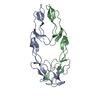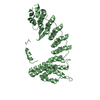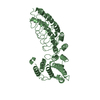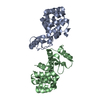+ Open data
Open data
- Basic information
Basic information
| Entry | Database: PDB / ID: 1ncf | ||||||
|---|---|---|---|---|---|---|---|
| Title | A NEW PARADIGM FOR TUMOR NECROSIS FACTOR SIGNALLING | ||||||
 Components Components | TUMOR NECROSIS FACTOR RECEPTOR | ||||||
 Keywords Keywords | SIGNALLING PROTEIN / BINDING PROTEIN / CYTOKINE | ||||||
| Function / homology |  Function and homology information Function and homology informationpositive regulation of amide metabolic process / tumor necrosis factor receptor superfamily complex / pulmonary valve development / positive regulation of lipid metabolic process / aortic valve development / tumor necrosis factor receptor activity / negative regulation of extracellular matrix constituent secretion / positive regulation of apoptotic process involved in morphogenesis / regulation of membrane lipid metabolic process / TNFs bind their physiological receptors ...positive regulation of amide metabolic process / tumor necrosis factor receptor superfamily complex / pulmonary valve development / positive regulation of lipid metabolic process / aortic valve development / tumor necrosis factor receptor activity / negative regulation of extracellular matrix constituent secretion / positive regulation of apoptotic process involved in morphogenesis / regulation of membrane lipid metabolic process / TNFs bind their physiological receptors / tumor necrosis factor binding / negative regulation of cardiac muscle hypertrophy / TNF signaling / regulation of establishment of endothelial barrier / regulation of tumor necrosis factor-mediated signaling pathway / TNFR1-mediated ceramide production / TNFR1-induced proapoptotic signaling / prostaglandin metabolic process / Interleukin-10 signaling / extrinsic apoptotic signaling pathway via death domain receptors / positive regulation of execution phase of apoptosis / cell surface receptor signaling pathway via JAK-STAT / tumor necrosis factor-mediated signaling pathway / TNFR1-induced NF-kappa-B signaling pathway / protein localization to plasma membrane / Regulation of TNFR1 signaling / cellular response to mechanical stimulus / negative regulation of inflammatory response / cytokine-mediated signaling pathway / intrinsic apoptotic signaling pathway in response to DNA damage / positive regulation of inflammatory response / signaling receptor activity / transcription by RNA polymerase II / positive regulation of canonical NF-kappaB signal transduction / receptor complex / defense response to bacterium / membrane raft / inflammatory response / Golgi membrane / cell surface / positive regulation of transcription by RNA polymerase II / extracellular space / extracellular region / membrane / plasma membrane Similarity search - Function | ||||||
| Biological species |  Homo sapiens (human) Homo sapiens (human) | ||||||
| Method |  X-RAY DIFFRACTION / Resolution: 2.25 Å X-RAY DIFFRACTION / Resolution: 2.25 Å | ||||||
 Authors Authors | Naismith, J.H. / Sprang, S.R. | ||||||
 Citation Citation |  Journal: J.Biol.Chem. / Year: 1995 Journal: J.Biol.Chem. / Year: 1995Title: Crystallographic evidence for dimerization of unliganded tumor necrosis factor receptor. Authors: Naismith, J.H. / Devine, T.Q. / Brandhuber, B.J. / Sprang, S.R. #1:  Journal: J.Mol.Biol. / Year: 1994 Journal: J.Mol.Biol. / Year: 1994Title: Two Crystal Forms of the Extracellular Domain of Type I Tumor Necrosis Factor Receptor Authors: Rodseth, L.E. / Brandhuber, B. / Devine, T.Q. / Eck, M.J. / Hale, K. / Naismith, J.H. / Sprang, S.R. #2:  Journal: Cell(Cambridge,Mass.) / Year: 1993 Journal: Cell(Cambridge,Mass.) / Year: 1993Title: Crystal Structure of the Soluble Human 55 Kd Tnf Receptor-Human Tnfb Complex: Implication for Tnf Receptor Activation Authors: Banner, D.W. / Arcy, A. / Janes, W. / Gentz, R. / Schoenfield, H. / Broger, C. / Loetscher, H. / Lesslauer, W. | ||||||
| History |
|
- Structure visualization
Structure visualization
| Structure viewer | Molecule:  Molmil Molmil Jmol/JSmol Jmol/JSmol |
|---|
- Downloads & links
Downloads & links
- Download
Download
| PDBx/mmCIF format |  1ncf.cif.gz 1ncf.cif.gz | 73.3 KB | Display |  PDBx/mmCIF format PDBx/mmCIF format |
|---|---|---|---|---|
| PDB format |  pdb1ncf.ent.gz pdb1ncf.ent.gz | 54.6 KB | Display |  PDB format PDB format |
| PDBx/mmJSON format |  1ncf.json.gz 1ncf.json.gz | Tree view |  PDBx/mmJSON format PDBx/mmJSON format | |
| Others |  Other downloads Other downloads |
-Validation report
| Summary document |  1ncf_validation.pdf.gz 1ncf_validation.pdf.gz | 371.3 KB | Display |  wwPDB validaton report wwPDB validaton report |
|---|---|---|---|---|
| Full document |  1ncf_full_validation.pdf.gz 1ncf_full_validation.pdf.gz | 373.2 KB | Display | |
| Data in XML |  1ncf_validation.xml.gz 1ncf_validation.xml.gz | 6.9 KB | Display | |
| Data in CIF |  1ncf_validation.cif.gz 1ncf_validation.cif.gz | 11.7 KB | Display | |
| Arichive directory |  https://data.pdbj.org/pub/pdb/validation_reports/nc/1ncf https://data.pdbj.org/pub/pdb/validation_reports/nc/1ncf ftp://data.pdbj.org/pub/pdb/validation_reports/nc/1ncf ftp://data.pdbj.org/pub/pdb/validation_reports/nc/1ncf | HTTPS FTP |
-Related structure data
| Similar structure data |
|---|
- Links
Links
- Assembly
Assembly
| Deposited unit | 
| ||||||||||||||||||||
|---|---|---|---|---|---|---|---|---|---|---|---|---|---|---|---|---|---|---|---|---|---|
| 1 |
| ||||||||||||||||||||
| Unit cell |
| ||||||||||||||||||||
| Noncrystallographic symmetry (NCS) | NCS oper:
| ||||||||||||||||||||
| Details | MTRIX THE TRANSFORMATIONS PRESENTED ON MTRIX RECORDS BELOW DESCRIBE NON-CRYSTALLOGRAPHIC RELATIONSHIPS AMONG THE VARIOUS DOMAINS IN THIS ENTRY. APPLYING THE APPROPRIATE MTRIX TRANSFORMATION TO THE RESIDUES LISTED FIRST WILL YIELD APPROXIMATE COORDINATES FOR THE RESIDUES LISTED SECOND. APPLIED TO TRANSFORMED TO MTRIX CHAIN RESIDUES CHAIN RESIDUES RMSD M1 A 15 .. A 52 B 15 .. B 52 0.214 THE NCS TRANSFORMATION BETWEEN DOMAIN 1 OF THE TWO MONOMERS IN THE ASYMMETRIC UNIT. M2 A 55 .. A 96 B 55 .. B 96 0.314 THE NCS TRANSFORMATION BETWEEN DOMAIN 2 OF THE TWO MONOMERS IN THE ASYMMETRIC UNIT. M3 A 98 .. A 137 B 98 .. B 137 0.348 THE NCS TRANSFORMATION BETWEEN DOMAIN 3 OF THE TWO MONOMERS IN THE ASYMMETRIC UNIT. M4 A 139 .. A 150 B 139 .. B 150 0.743 THE NCS TRANSFORMATION BETWEEN DOMAIN 4 OF THE TWO MONOMERS IN THE ASYMMETRIC UNIT. S1 B 13 .. B 156 ? 13 .. ? 156 THIS GENERATES A MOLECULE WHICH MAY FORM AN ALTERNATIVE DIMER TO THE ONE DESCRIBED BY THE COORDINATES. SYMMETRY1 1 -1.000000 0.000000 0.000000 34.50000 SYMMETRY2 1 0.000000 1.000000 0.000000 -34.50000 SYMMETRY3 1 0.000000 0.000000 -1.000000 46.30000 |
- Components
Components
| #1: Protein | Mass: 18335.830 Da / Num. of mol.: 2 / Mutation: R11M Source method: isolated from a genetically manipulated source Details: THE CONSTRUCT CONTAINS RESIDUES 12 - 172 OF THE MATURE RECEPTOR SEQUENCE Source: (gene. exp.)  Homo sapiens (human) Homo sapiens (human)Description: RESIDUE 11 IS MUTATED TO MET AS A RESULT OF THE EXPRESSION SYSTEM Production host:  #2: Water | ChemComp-HOH / | Has protein modification | Y | Sequence details | SOURCE 1 THE CONSTRUCT CONTAINS RESIDUES 12 - 172 OF THE MATURE SEQUENCE OF THE ENTIRE RECEPTOR. ...SOURCE 1 THE CONSTRUCT CONTAINS RESIDUES 12 - 172 OF THE MATURE SEQUENCE OF THE ENTIRE RECEPTOR. RESIDUE 11 IS MUTATED TO MET AS A RESULT OF THE EXPRESSION | |
|---|
-Experimental details
-Experiment
| Experiment | Method:  X-RAY DIFFRACTION X-RAY DIFFRACTION |
|---|
- Sample preparation
Sample preparation
| Crystal | Density Matthews: 3 Å3/Da / Density % sol: 59.06 % | ||||||||||||||||||||||||||||||||||||||||||||||||||||||||||||
|---|---|---|---|---|---|---|---|---|---|---|---|---|---|---|---|---|---|---|---|---|---|---|---|---|---|---|---|---|---|---|---|---|---|---|---|---|---|---|---|---|---|---|---|---|---|---|---|---|---|---|---|---|---|---|---|---|---|---|---|---|---|
| Crystal grow | *PLUS Temperature: 293 K / pH: 8.5 / Method: vapor diffusion, sitting drop / Details: Rodseth, L.E., (1994) J.Mol.Biol., 239, 332. | ||||||||||||||||||||||||||||||||||||||||||||||||||||||||||||
| Components of the solutions | *PLUS
|
-Data collection
| Radiation | Scattering type: x-ray |
|---|---|
| Radiation wavelength | Relative weight: 1 |
| Reflection | Num. obs: 24198 / % possible obs: 100 % / Observed criterion σ(I): 0 |
| Reflection | *PLUS Highest resolution: 2.25 Å / Num. obs: 21874 / Redundancy: 6.5 % / Rmerge(I) obs: 0.051 |
| Reflection shell | *PLUS Mean I/σ(I) obs: 5.2 |
- Processing
Processing
| Software |
| ||||||||||||||||||||||||||||||||||||||||||||||||||||||||||||||||||||||||||||||||
|---|---|---|---|---|---|---|---|---|---|---|---|---|---|---|---|---|---|---|---|---|---|---|---|---|---|---|---|---|---|---|---|---|---|---|---|---|---|---|---|---|---|---|---|---|---|---|---|---|---|---|---|---|---|---|---|---|---|---|---|---|---|---|---|---|---|---|---|---|---|---|---|---|---|---|---|---|---|---|---|---|---|
| Refinement | Resolution: 2.25→6 Å / σ(F): 3
| ||||||||||||||||||||||||||||||||||||||||||||||||||||||||||||||||||||||||||||||||
| Displacement parameters | Biso mean: 31.58 Å2 | ||||||||||||||||||||||||||||||||||||||||||||||||||||||||||||||||||||||||||||||||
| Refinement step | Cycle: LAST / Resolution: 2.25→6 Å
| ||||||||||||||||||||||||||||||||||||||||||||||||||||||||||||||||||||||||||||||||
| Refine LS restraints |
| ||||||||||||||||||||||||||||||||||||||||||||||||||||||||||||||||||||||||||||||||
| Refinement | *PLUS Rfactor all: 0.208 | ||||||||||||||||||||||||||||||||||||||||||||||||||||||||||||||||||||||||||||||||
| Solvent computation | *PLUS | ||||||||||||||||||||||||||||||||||||||||||||||||||||||||||||||||||||||||||||||||
| Displacement parameters | *PLUS | ||||||||||||||||||||||||||||||||||||||||||||||||||||||||||||||||||||||||||||||||
| Refine LS restraints | *PLUS
|
 Movie
Movie Controller
Controller









 PDBj
PDBj









